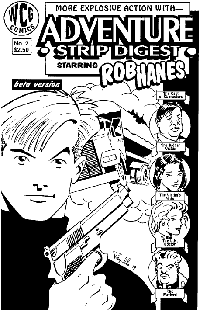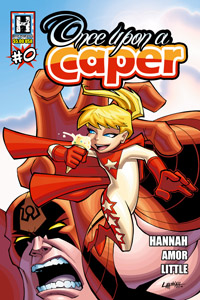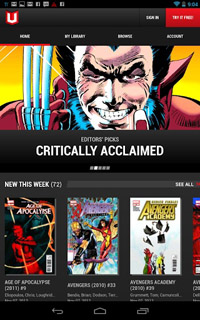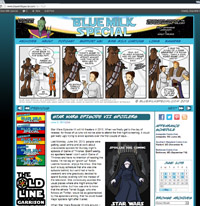This is part 1 of a 5 part series collecting much of my experience and advice. Whether you’re planning to make a comic, or already working on one, there are many things to consider and I can’t promise to cover them all.
All you need to make a comic is a little bit of creative storytelling skill and determination. How much money you need will depend on how much you can do on your own, as well as what sort of comic you are trying to make. If you need a lot of money for printing, there’s always Kickstarter.
A great example of that independent spirit of amateur comic book making can be found at Anime Conventions in artist alley where many writers and artists shop their amateur mangas. At comic conventions like Baltimore Comic Con and Heroes Con you’ll find a huge emphasis on the creators and a large section of the hall devoted exclusively to them.
 It’s tough making comics on your own and even more challenging working with a team! The more ambitious the project, the tougher it gets. However, having your own printed comic in your hands is a good feeling, and knowing the story you wrote means something to a reader is even better!
It’s tough making comics on your own and even more challenging working with a team! The more ambitious the project, the tougher it gets. However, having your own printed comic in your hands is a good feeling, and knowing the story you wrote means something to a reader is even better!
Ashcans: A term for a do-it-yourself comic. All you need is access to a printer/copier and a stapler. Often, Ashcans are entirely black and white and with a smaller page count, but it is really up to you. Think of it as a sampler or preview issue for promoting your upcoming work. However, if you just want to make comics this way, what’s to stop you? A great place to sell these is by getting your own table at local anime / manga conventions (usually a bit cheaper than comic conventions and with a more receptive audience to indie comics). To save on costs, you can split the table fee with friends and share the space to promote each other’s works.
Print On-Demand Comics: Full color independent comics like Once Upon A Caper‘s early print runs were printed through on-demand printers like Ka-Blam and listed on Indy Planet. But you don’t have to go full color. You can have a color cover with black and white interior to save a little on print costs, or for aesthetic choice.

- The down side is that you won’t get the sort of savings that you would if you were using a large printing company. This is how publishers like Marvel, DC, Image, IDW and Dark Horse can have a comparatively low cover price compared to your print on-demand book.
- Although your profit margin is less, you don’t have to place an order for a huge print run either and worry about boxes of back issues you were unable to sell.
- A lot of people who support indie comics will pay a little more because they are happy to support the little guy.
- Black & White issues cost about as much as a full color book from Marvel. While full color on-demand issues cost a lot more, forcing you to bump up your cover price to make any profit. When I used Ka-Blam, Once Upon A Caper cost $3.50 to print, though I could have saved a fraction if I let them include one of their Ka-Blam ads. The Ka-Blam ad is a bit of an eye-sore, but it you don’t mind it, it can knock that printing price down to as low as $2.90. Although Ka-Blam and on-demand printing are no longer my preference, they are good in a pinch when you need a book quickly and without having to invest in a minimum quantity of 100 or more at a larger print company.
- Indy Planet is Ka-Blam’s online store, however there is no quality control for the titles listed and there are thousands. The best way for people to find your book in their store is to point them right to it through your promotional activities. Indy Planet also has a massive drawback for the customer who has to wait up to 3 weeks for a the book to be printed and shipped. For some, that is too long. In the end, you’re likely to use Ka-Blam to print copies for your own stock to take to conventions than you are to sell many through their Indy Planet store. I created my own website to promote Once Upon A Caper and pointed it to their store, however I am not printing issues elsewhere and shipping them out myself. Quicker for the customer. Just something to think about.
 Digital Comics: I offered Once Upon A Caper as a digital download in PDF format via PayLoadZ.com for $0.99 cents. I offered it for so low because I figured the promotion I would get would be worth more than an extra $0.50 cents that might otherwise put someone off buying it. UPDATE 7.16.2013 – With the revised version of Once Upon A Caper I had intended to take advantage of Indy Planet Digital until I discovered how backed up the staff are. After my print edition went live on Indy Planet on July 3rd, I am STILL waiting for the digital to appear. Their response was that they are so backed up they won’t even give an estimate when it might be available. So I had no choice but to do it myself via PayloadZ.com once again. I upped my price to $1.99, giving me $1.50 profit off each sale. To date, my digital sales have been about 500% better than my print sales. So seriously, just do it yourself with Payloadz.
Digital Comics: I offered Once Upon A Caper as a digital download in PDF format via PayLoadZ.com for $0.99 cents. I offered it for so low because I figured the promotion I would get would be worth more than an extra $0.50 cents that might otherwise put someone off buying it. UPDATE 7.16.2013 – With the revised version of Once Upon A Caper I had intended to take advantage of Indy Planet Digital until I discovered how backed up the staff are. After my print edition went live on Indy Planet on July 3rd, I am STILL waiting for the digital to appear. Their response was that they are so backed up they won’t even give an estimate when it might be available. So I had no choice but to do it myself via PayloadZ.com once again. I upped my price to $1.99, giving me $1.50 profit off each sale. To date, my digital sales have been about 500% better than my print sales. So seriously, just do it yourself with Payloadz.
Comixology has been on the block longer and has an app that makes it available on mobile devices via iTunes and Google Play. It serves digital comics from the big publishers and as a consequence provides a considerable challenge for your comic to get noticed amongst the glut of industry heavy weights. I’m hearing that a lot of money is being made by digital comics sold via apps like Comixology so it’s something to consider very seriously. Apps however, cost money, and each issue is essentially converted to an app for a fee by a third party. This may have changed since I last looked into it. We’re talking in the hundreds of dollars per issue. Other options involve the third party taking a cut of each sale.
One of the big benefits of having created your own self-published independent comic is that it becomes a portfolio piece, both for writers and artists. It’s your show reel or demo tape. It says to any publisher or potential colleague that you can successfully put an entire comic together and that you have some professional experience. It doesn’t just have to be a vanity project.
 Webcomics: Comics designed to read online in a web browser (almost always for free) that you either host on your own website, or via a webcomic hub site like Webcomicsnation.com. You can list your webcomic with InkOutBreak.com which allows readers to navigate through your many pages of story more easily as well as bringing in new readers from the webcomic reading community.
Webcomics: Comics designed to read online in a web browser (almost always for free) that you either host on your own website, or via a webcomic hub site like Webcomicsnation.com. You can list your webcomic with InkOutBreak.com which allows readers to navigate through your many pages of story more easily as well as bringing in new readers from the webcomic reading community.
While many webcomic creators collect the online pages and print them in some sort of comic style publication, many remain exclusively online. This means that you don’t have to spend money printing anything if you don’t want to. Comics like Beast Legion hire and pay artists, but many webcomics are collaborations or written and illustrated by the creator.
Webcomics can be a good way to test the market and build a following prior to making the jump to the print medium, but you can stay entirely digital too. There is a lot of flexibility in webcomics, and the range of quality goes from very amateur to highly professional. Although there are a LOT of webcomics out there, some have become so successful that the authors are earning a living or finding massive success with KickStarter. That being said, Rich Burlew did not make over $1 million dollars via Kickstarter until his webcomic, Order of the Stick, had been running and building its audience for 9 years.
I’ll talk more about how to create webcomics and how I set up Blue Milk Special in Part 3 of this feature.
Part 2 – The Harsh Realities
Part 3 – Making Webcomics
Part 4 – Promotion
Part 5 – Comic Conventions

fascinating rod. i’m looking forward to reading parts 1, 2 & 3!
John